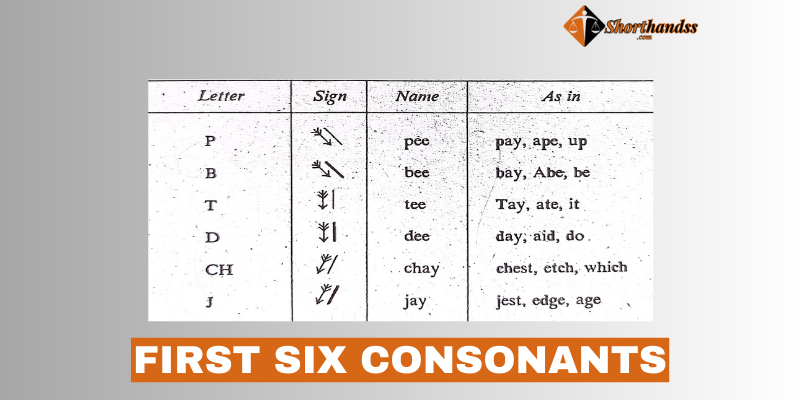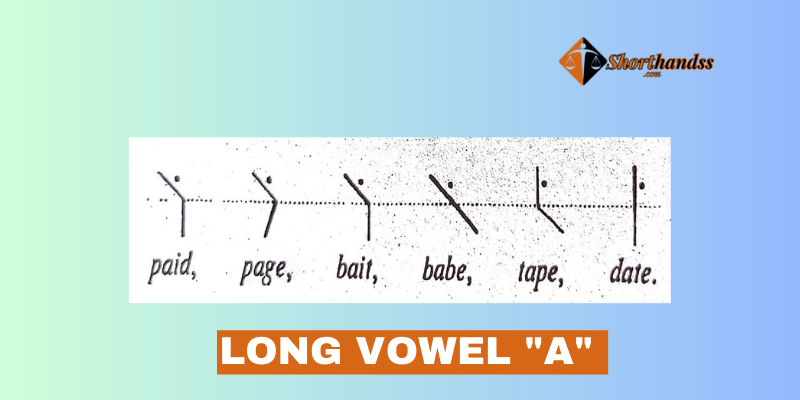The sounds heard in the English language are, in Pitman’s Shorthand divided into three parts because of their sounds. These sounds are represented by a different symbol because each stroke represents a different sound of Consonants Vowels and Diphthongs. A shorthand sign is provided for each of these sounds. The first type of symbol in shorthand language is called consonant or Strokes. It is also called an outline. There are 24 symbols of consonants in this language. The second type of symbol in shorthand language is called Vowels. There are 12 vowels in this language and the third type of symbol in shorthand language is called Diphthongs. There are four diphthongs in this language. So first of all we discuss Consonants.
First Six Consonants
The consonants of the shorthand language are represented by simple outline, These consonants are also called strokes. For each consonant’s sounds pitman’s shorthand provides an outline. These outlines are different from each other. Some outlines are written in the same position and same direction. But the light and heavy concepts are present between them. In Shorthand, most strokes are written downward and curved. The first six consonants are written downwards. All six strokes are written straight down. The length of all strokes is equal to 1/3 of the Urdu line.
The arrows in the picture indicate the directions in which strokes’ are written. They are never written any other direction because due to this stroke direction is changed and the stroke is awkward and provides a different position. It is a basic rule of Pitman’s shorthand that the stroke is always written its proper direction. These six consonants are paired with each other such as P and B, T, and D, and Ch and J, In each pair light sound is represented by a light stroke, and a heavy sound is represented by a heavier stork because of sound difference. For a better experience, students must write three pages of each stroke and keep in mind the difference between light and heavy sounds or strokes because practice makes a man perfect.

2) Vowels with Consonants
Vowels are represented by dots and dashes in Shorthand. That is written alongside the consonant strokes. When vowels come before consonants it is placed before the stroke / left side of strokes. When vowels come after a consonant, it is placed after the stroke / right side of the strokes. There are a total number of vowels in shorthand is 12. These vowels are divided into three places four in first, four in second, and four in third. First place means the beginning part of the stroke, Second place means the middle part of the stroke and third place means the ending part of the stroke. First, we discuss second places vowels. There are four vowels in second place.
In the Shorthand language, there are two basic principles according to writing in second place. First upward or downward stroke rest on the line. The vowels are placed in the middle part of the stroke. When in any word two strokes produce a clear sound then we place the first stroke on the line and the second stroke written after the ending of the first stroke. Both strokes are written in their proper position. If the vowel come before the first stroke then it’s placed before the first stroke and if the vowel comes after the first stroke then it’s placed after the first place. But keep in mind vowels are always written in mid of the stroke in second place. It is not written in any other place. If vowels come with a second stroke then it is placed with a second stroke.
Long Vowel “a”
The long vowel “a” is the first vowel of second place. In the second-place stroke rest on the line and the vowel is placed in the middle of the stroke. Long vowel “a” produces us clean sound of “a”, as we hear in simple English. “a” is the first vowel of shorthand language. The long vowel “a” is represented by a heavy dot (.). It means that Where we hear the clear sound “a” in English. We use a dot for the sound of “a” in shorthand language. In shorthand, we write the consonants stroke first and then place the vowel sign.
Two light dishes underneath an outline indicate that the word represented begins with a capital letter. In simple we know that where the sentence begins the first Alphabet of the sentence is capital letter. But in another case if in the middle of the sentence any word begins with a capital letter such as any noun or special thing. Then we use two light dishes underneath an outline for the capital alphabet. It is mentioned that the word starts with capital letters. See the words mentioned above and try to write down three pages of these words. For a better experience use a pencil because it is more effective than a pen. Shorthand requires lots of time for practice because it is difficult for new learners.

For Short hand related jobs visits:-

